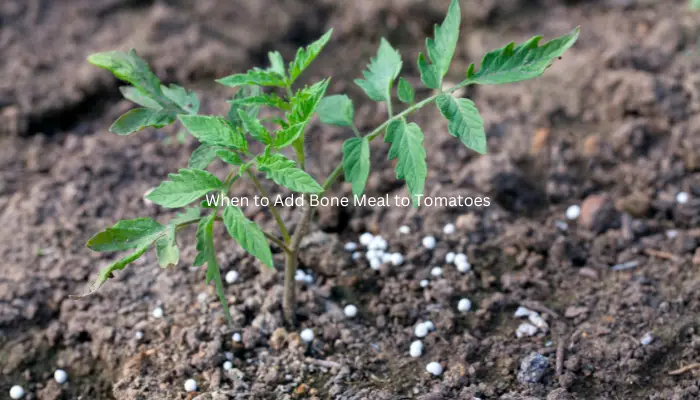Including bone meal in your gardening practice is one way to guarantee that your tomato plants receive the vital nutrients they need.
Tomato plants can greatly benefit from the natural fertilizer bone meal, but when to apply it is very important.
We go into the facets of when and how to fertilize tomatoes with bone meal for healthy growth and abundant harvests in this extensive tutorial.
What is Bone Meal
Ground animal bones, usually from cattle, are used to make bone meal, an organic fertilizer.
It contains a lot of important elements, including calcium and phosphorus, which are necessary for plant development.
Fruit production, root growth, and general plant health are all greatly influenced by phosphorus.
On the other hand, conditions like blossom end rot, which can degrade the flavor of your tomato fruits, are prevented by calcium.
Additionally, trace nutrients included in bone meal support the establishment of healthy plants.
So, when should you add bone meal to your tomato plants?
When to Add Bone Meal to Tomatoes?

When you are planting your tomato plants is the best time to apply bone meal.
Before you transplant your tomato seedlings, mix in some bone meal to the soil to provide them a solid growing base.
At this point, when adding bone meal, adhere to these steps:
Step 1. Dig a hole deep enough to accommodate the root ball of your tomato seedling.
Step 2. Sprinkle a handful of bone meal at the bottom of the hole.
Step 3. Place your tomato seedling in the hole and cover it with soil.
Step 4. Water the plant thoroughly to settle the soil and activate the bone meal.
Early Growth Stage
Tomato plants grow through multiple stages, starting with germination and ending with flowering and fruiting.
In order to guarantee that your tomato plants get off to a healthy start and to encourage strong root development, it is beneficial to give them a boost of calcium and phosphorus throughout the early growth stage, which usually includes the first few weeks following transplantation.
Around two to three weeks after transplanting, sprinkle bone meal evenly around the base of your tomato plants.
Be sure to avoid direct contact between the bone meal and the plant’s stem to prevent burning. Water the area thoroughly to help the bone meal release its nutrients into the soil.
At First Blossom
When your tomato plants start to bloom, it’s an exciting milestone because it means that fruit production is about to begin.
This is a great opportunity to supplement your tomatoes with bone meal.
Plants need more phosphorus as they go from vegetative to reproductive growth in order to support the development of flowers and fruits.
To provide your tomato plants with the necessary nutrients during the flowering stage, sprinkle bone meal around the base of each plant.
Focus on applying the bone meal near the root zone and water it in thoroughly.
This helps ensure that the nutrients are readily available when the plants need them most.
As a Maintenance Dose
It’s an exciting milestone when your tomato plants begin to bloom because it signals the impending start of fruit production.
This is an excellent chance to add bone meal to your tomatoes.
When a plant transitions from vegetative to reproductive growth, it needs more phosphorus to support the growth of fruits and flowers.
Apply bone meal approximately every 4-6 weeks during the growing season.
Ensure the bone meal is spread evenly around the base of the plants, but avoid direct contact with the stem.
Water the area after application to facilitate nutrient absorption by the roots.
Preventative Measures
Although these are the best times to fertilize your tomato plants with bone meal, it should be emphasized that bone meal is a slow-release fertilizer.
This implies that it might take some time for the plants to start receiving its nutrients.
Therefore, you can ascertain the nutrient requirements of your particular garden by taking a proactive approach to soil testing.
Before the growing season begins, a soil test can give you important information about the nutrient composition of your soil.
To suit the unique requirements of your tomato plants, you can modify your fertilization plan based on the findings of the soil test.
It is even more crucial to include bone meal in your regular fertilizer routine if the soil test results show a calcium or phosphorus deficiency.
Related Post: How to Grow and Enjoy Super Steak Tomatoes
Conclusion
A plentiful harvest of tomatoes is a gardener’s dream since they are a common feature in many gardens.
Giving your tomato plants the right nutrients at the right times is essential to their success.
With its high calcium and phosphorus content, bone meal can be a beneficial supplement to your tomato-growing routine.
You may support the development of robust root systems in your tomato plants, encourage the production of flowers and fruits, and preserve overall plant health by applying bone meal at different times, such as during planting, early growth, at the first blossoms, and as a maintenance dosage.
Keep in mind that bone meal is a slow-releasing fertilizer, so schedule your applications appropriately.
You can adjust your fertilization strategy to match the unique nutrient requirements of your garden by conducting routine soil tests.
You can anticipate a bountiful harvest of tasty, homegrown tomatoes with appropriate maintenance and the timely addition of bone meal.




